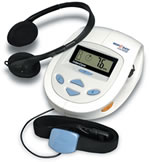 Dr. William Elliott who is professor of preventive medicine and internal medicine and pharmacology at Rush Medical College in Chicago believes, “Device-guided paced breathing may offer an effective, simple, and new nonpharmacological option for treating high blood pressure [BP].”
Dr. William Elliott who is professor of preventive medicine and internal medicine and pharmacology at Rush Medical College in Chicago believes, “Device-guided paced breathing may offer an effective, simple, and new nonpharmacological option for treating high blood pressure [BP].”
Here’s a summary of clinical studies using the RESPeRATE device.
All listed results are significantly better than placebo.
Journal of Human Hypertension, 2001
- Reduced systolic BP, diastolic BP, and mean arterial blood pressure (MAP) by 15, 10 and 12 mm Hg, respectively
- Benefits lasted 6 months after treatment stopped
Journal of Human Hypertension, 2001 (a second study)
- 33 adults with uncontrolled high blood pressure
- Home-measured BP was lowered by 5/3 mm Hg
- 10 of 18 (56%) were defined as responders
American Journal of Hypertension, 2004
- Reduced home BP by 5/3 mm Hg
Journal of Clinical Hypertension, 2004
- Greater decreases in systolic BP for those who spent more than 180 minutes over 8 weeks in slow breathing training (-15 vs. -7 mm Hg)
American Journal of Hypertension, 2003
- Home BP was lowered by 6/3 mm Hg without side effects
- 82% were responders
The bottom line?
- Systolic blood pressure (the higher number) can be lowered by 5 to 15 mm Hg.
- Benefit is possible in patients with “uncontrolled” high blood pressure.
- Those who spend more time learning the technique achieve better results.
- The benefits remain after the training ends.
Compared to other nonpharmacological treatments, device-guided paced breathing works pretty well as a complement to pharmacological therapy.
- Salt restriction: -2-8 mm Hg
- Weight loss: -5-20 mm Hg/10 kg (22lb) weight loss
- Exercise: -4-9 mm Hg
- Moderate alcohol consumption: -2-4 mm Hg
4/6/07 12:57 JR